update: @Guyando115 has brought it to my attention that there is a steam-engine app on google play store, which is a pay version of the website i link to below throughout the tutorial. it apparently doesnt have all the features that the web site does, and it wont allow you to follow along with the tutorial here at all. if you are using a mobile device, just go to the steam engine page in your browser and skip the app download 
steam engine is a site that hosts a series of essential tools for anyone who vapes. it covers wire building and coil wrapping, an ohms law and battery draw calculator, and an e-liquid tool. its a lot to take in at first, so this thread is going to try to cover the basics, and provide a place to consolidate as much info as possible. feel free to ask for help, help out, or add to the tutorials or tips. im going to try to cover wire wizard and quickly explain the ohms law calculator to get things started.
wire wizard is a wire planning tool that helps you spec out a build 'on paper'. it does a lot of math to give you a very good estimate of your builds final resistance, and lets you tinker with all the details to make sure you get your target. there are a lot of options and variables to play with/get overwhelmed by, so lets get into it. this is usually the first step i take in making anything.
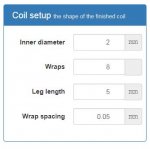
here is where you choose the size of your coil. the inner diameter is the size of the object (coil jig/mandrel, screwdriver, drill bit etc) you will wrap your wire around to make a coil. basically the idea is to choose the size that works best for your atomizer, but you can tinker with it a little to adjust the final resistance as well. most atomizers are fine with 3mm coils, so thats a good place to start if you are unsure.
wraps is the amount of times you wrap the coil around the object above. one full wrap ends with the 'legs' pointing in opposite directions. most coils in dual coil atomizers have the legs pointing in the same direction, resulting in a half wrap. if you can count 5 wraps on the 'front' (both legs pointing away from you) its a 4.5 wrap coil (also referred to as a 5/4 wrap).
diameter and wraps can both be adjusted to change the final resistance of a build, but keep in mind that there is a balance of coil mass and output power dictating how well it will vape. throwing a couple extra wraps onto a coil will make it take longer to heat up, or require more power to heat up at the same rate. on a regulated mod, this is easily overcome by turning up the power, but it can be wasteful for battery life and end up transferring a lot of heat into your hardware and cooking your juice long after you stop vaping. on a mech mod, increasing the mass this way will raise the resistance and cause the build to pull less power from the batteries, which makes ramp up even worse (similar to turning down the wattage on a regulated mod). in contrast to that, you can make a coils a little smaller and it will lower the resistance a bit, as well as the mass, which will increase the speed it heats up (on a mech mod).
leg length is something i just ignore. changing it doesnt really change your final resistance in any meaningful way, or give you a more accurate estimate. the same goes for wire spacing. i have never changed those values and my output from wire wiz is always nearly dead on accurate.

in the wire builder menu, you can choose between a variety of core configurations, as well as wire type (round or ribbon) and size (awg). it also shows you the actual size of a given gauge in mm. you will need this info later for certain builds (alien variants all require a bit of math based on core width and decore size, or trying to match ribbon and round wire size etc). larger wire/lower gauge is lower resistance (can carry more current. think of a large diameter water hose compared to a small one), with high gauges being higher resistance.

the ribbon wire size selector will let you input any size of ribbon or square/rectangular wire.

the core config menu lets you choose between parallel, twisted, clapton or staggered fused clapton. each option has its own set of options, depending on the specific variables for that build type.
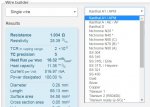
here is where you can choose the metal that your wire is made from. make sure to always get this right because the various metals we use all have different resistances, and making a mistake with this will give you an inaccurate final resistance.

here you can choose two (or more) different 'things' to run parallel (wrapped side by side around your coil jig 'object' from the first steps). in those drop down boxes, you can choose to set up two different clapton wires if you want, or as many as you want to run, by hitting that small box with the + in it, which will add another box like the two in the picture. adding core wires will divide your final resistance by the number of core wires (if they are all the same gauge, the math is more complex for mixing different types/gauges etc).

the twisted wire menu will only let you twist 4 wires together at max, but you can choose all the familiar options (single, twisted, clapton etc) from the dropdown box, so you could technically choose twisted again to get more if you need them. the pitch is the amount of space between your twists. its not super important to get perfect here. if it throws an error, its because your wire is thicker than the twist pitch (impossible in the real world), just increase it until it stops showing the error.

the clapton tool allows you to choose a core (again, parallel, twisted, clapton etc), and a wrap wire (which could also be twisted/parallel etc). this is the section i use to do most of my builds. you can set up some complex stuff in here by choosing parallel as the core and then adding in whatever/how many you want with that little + button...2 round wire cores for fused claptons, three for aliens, mix ribbon and round for a framed staple etc. the wrap wire has such a small effect on the final resistance that there is virtually no difference here in wrap wire between alien, clapton, staggs, pitchforks, etc. as long as i set up my core wires exactly, i can just set the gauge/material on my wrap wire and get an accurate resistance estimate no matter what my actual wrap will be (half staggered, spaced, tightly wrapped etc).

this is for staggered fused claptons. by default, it assumes that you have two spaced clapton wrapped cores of some kind, with another wrap wire fusing them together in between the spaces...it limits you to only two cores or stacks (could be single wire, or parallel, twisted etc), with no way to input anything in between (like an ssfc which is a ribbon stack stuffed into a regular sfc).

this is the final output box that tells you some important things. your resistance is only for a single coil. if you are planning to use more than one coil in the build, divide this number by the amount of coils (for a dual coil setups, divide by two, quad coils divide by four etc). the width is only accurate if you arent using ribbon wire (as of this post, it calculates the ribbon on the wrong axis, so 2 pieces of .5 x.1mm ribbon are calculated as being 1mm wide, but we stack them on their sides, so 2 .5 x.1mm ribbons should be .2mm wide - edit - @Pegleg Meg came up with a smart solution here). the length is important to note, so you know how much wire to build. its also for one coil only, so you should multiply it by the amount of coils you want (they have a unit converter there), and add an inch or two to that total (the parts you clamp into your drill and swivels are unusable)...and consider making extra if you arent sure its going to come out perfect. i like to shoot for three coils on hard builds in case i make a mistake (usually the mistake will be confined to one coil, or i can work around it). take note of the surface area and mass as well. with experience you will get a feel for that balance of mass and power i was talking about earlier. i will follow up this post with some pics of builds set up in wire wiz, and the actual coils with their actual (real life) resistance for reference.
if anyone wants to cover the temp control results window, how to use it for dna mods and escribe, heat flux and heat capacity, and anything else i missed, that would be great
links to all the 'official' threads are collected here, have a look through the rest for tips on everything from beginner to advanced builds, and even coil photography.

steam engine is a site that hosts a series of essential tools for anyone who vapes. it covers wire building and coil wrapping, an ohms law and battery draw calculator, and an e-liquid tool. its a lot to take in at first, so this thread is going to try to cover the basics, and provide a place to consolidate as much info as possible. feel free to ask for help, help out, or add to the tutorials or tips. im going to try to cover wire wizard and quickly explain the ohms law calculator to get things started.
wire wizard is a wire planning tool that helps you spec out a build 'on paper'. it does a lot of math to give you a very good estimate of your builds final resistance, and lets you tinker with all the details to make sure you get your target. there are a lot of options and variables to play with/get overwhelmed by, so lets get into it. this is usually the first step i take in making anything.

here is where you choose the size of your coil. the inner diameter is the size of the object (coil jig/mandrel, screwdriver, drill bit etc) you will wrap your wire around to make a coil. basically the idea is to choose the size that works best for your atomizer, but you can tinker with it a little to adjust the final resistance as well. most atomizers are fine with 3mm coils, so thats a good place to start if you are unsure.
wraps is the amount of times you wrap the coil around the object above. one full wrap ends with the 'legs' pointing in opposite directions. most coils in dual coil atomizers have the legs pointing in the same direction, resulting in a half wrap. if you can count 5 wraps on the 'front' (both legs pointing away from you) its a 4.5 wrap coil (also referred to as a 5/4 wrap).
diameter and wraps can both be adjusted to change the final resistance of a build, but keep in mind that there is a balance of coil mass and output power dictating how well it will vape. throwing a couple extra wraps onto a coil will make it take longer to heat up, or require more power to heat up at the same rate. on a regulated mod, this is easily overcome by turning up the power, but it can be wasteful for battery life and end up transferring a lot of heat into your hardware and cooking your juice long after you stop vaping. on a mech mod, increasing the mass this way will raise the resistance and cause the build to pull less power from the batteries, which makes ramp up even worse (similar to turning down the wattage on a regulated mod). in contrast to that, you can make a coils a little smaller and it will lower the resistance a bit, as well as the mass, which will increase the speed it heats up (on a mech mod).
leg length is something i just ignore. changing it doesnt really change your final resistance in any meaningful way, or give you a more accurate estimate. the same goes for wire spacing. i have never changed those values and my output from wire wiz is always nearly dead on accurate.

in the wire builder menu, you can choose between a variety of core configurations, as well as wire type (round or ribbon) and size (awg). it also shows you the actual size of a given gauge in mm. you will need this info later for certain builds (alien variants all require a bit of math based on core width and decore size, or trying to match ribbon and round wire size etc). larger wire/lower gauge is lower resistance (can carry more current. think of a large diameter water hose compared to a small one), with high gauges being higher resistance.

the ribbon wire size selector will let you input any size of ribbon or square/rectangular wire.
the core config menu lets you choose between parallel, twisted, clapton or staggered fused clapton. each option has its own set of options, depending on the specific variables for that build type.

here is where you can choose the metal that your wire is made from. make sure to always get this right because the various metals we use all have different resistances, and making a mistake with this will give you an inaccurate final resistance.

here you can choose two (or more) different 'things' to run parallel (wrapped side by side around your coil jig 'object' from the first steps). in those drop down boxes, you can choose to set up two different clapton wires if you want, or as many as you want to run, by hitting that small box with the + in it, which will add another box like the two in the picture. adding core wires will divide your final resistance by the number of core wires (if they are all the same gauge, the math is more complex for mixing different types/gauges etc).

the twisted wire menu will only let you twist 4 wires together at max, but you can choose all the familiar options (single, twisted, clapton etc) from the dropdown box, so you could technically choose twisted again to get more if you need them. the pitch is the amount of space between your twists. its not super important to get perfect here. if it throws an error, its because your wire is thicker than the twist pitch (impossible in the real world), just increase it until it stops showing the error.

the clapton tool allows you to choose a core (again, parallel, twisted, clapton etc), and a wrap wire (which could also be twisted/parallel etc). this is the section i use to do most of my builds. you can set up some complex stuff in here by choosing parallel as the core and then adding in whatever/how many you want with that little + button...2 round wire cores for fused claptons, three for aliens, mix ribbon and round for a framed staple etc. the wrap wire has such a small effect on the final resistance that there is virtually no difference here in wrap wire between alien, clapton, staggs, pitchforks, etc. as long as i set up my core wires exactly, i can just set the gauge/material on my wrap wire and get an accurate resistance estimate no matter what my actual wrap will be (half staggered, spaced, tightly wrapped etc).

this is for staggered fused claptons. by default, it assumes that you have two spaced clapton wrapped cores of some kind, with another wrap wire fusing them together in between the spaces...it limits you to only two cores or stacks (could be single wire, or parallel, twisted etc), with no way to input anything in between (like an ssfc which is a ribbon stack stuffed into a regular sfc).

this is the final output box that tells you some important things. your resistance is only for a single coil. if you are planning to use more than one coil in the build, divide this number by the amount of coils (for a dual coil setups, divide by two, quad coils divide by four etc). the width is only accurate if you arent using ribbon wire (as of this post, it calculates the ribbon on the wrong axis, so 2 pieces of .5 x.1mm ribbon are calculated as being 1mm wide, but we stack them on their sides, so 2 .5 x.1mm ribbons should be .2mm wide - edit - @Pegleg Meg came up with a smart solution here). the length is important to note, so you know how much wire to build. its also for one coil only, so you should multiply it by the amount of coils you want (they have a unit converter there), and add an inch or two to that total (the parts you clamp into your drill and swivels are unusable)...and consider making extra if you arent sure its going to come out perfect. i like to shoot for three coils on hard builds in case i make a mistake (usually the mistake will be confined to one coil, or i can work around it). take note of the surface area and mass as well. with experience you will get a feel for that balance of mass and power i was talking about earlier. i will follow up this post with some pics of builds set up in wire wiz, and the actual coils with their actual (real life) resistance for reference.
if anyone wants to cover the temp control results window, how to use it for dna mods and escribe, heat flux and heat capacity, and anything else i missed, that would be great

links to all the 'official' threads are collected here, have a look through the rest for tips on everything from beginner to advanced builds, and even coil photography.
Last edited:


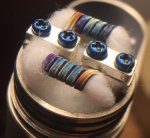

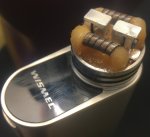

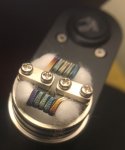

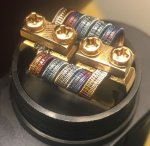



 i am still making little edits and finding mistakes, but i think its mostly solid and coherent now...
i am still making little edits and finding mistakes, but i think its mostly solid and coherent now...













